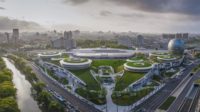In digitally sophisticated Los Angeles, the Southern California Institute of Architecture's new Robot House ups the ante.
The architects Peter Testa and Devyn Weiser like to point out that the robots are not people. The robots, in this case, are five white robotic arm Stäubli instruments installed last spring in the new Robot House at the Southern California Institute of Architecture (SCI-Arc) in Los Angeles. For that matter, the Robot House is not a house, but rather a converted double-height space at the south end of SCI-Arc’s main building. The room has two glass walls and a catwalk overhead, which allow students to view the robots in action.
Testa and Weiser, partners in the firm Testa/Weiser and faculty members at SCI-Arc, initiated the school’s partnership with Stäubli and oversaw the Robot House’s design and construction. The five robots in the facility, along with a sixth, much smaller one in an adjacent classroom, range in weight from 60 to 550 pounds and can handle loads of up to 75 pounds, moving as fast as 35 feet per second. They might not be people, but they may well populate the next frontier of digital design.
Similar models of robots build cars, process pharmaceuticals, and perform surgery, guaranteeing precision and consistency. In architecture, robots have mostly been used individually to “pick and place” materials, such as bricks. But with multiple robots, designers can investigate movement, choreography, and collaboration, providing an alternative to the typical linear sequence of design and programming, followed by fabrication and construction. “We consider the robots a real-time design and construction platform,” explains Testa. Robots offer a way of getting beyond the computer screen, which doesn’t account for gravity or material properties. “We wanted to move on to something more tangible and interactive,” he says. Robots could also enable free-form fabrication, minimizing or eliminating the use of molds. This summer, Weiser taught the first seminar using the robots, called Robotic Confections and Confabulations, or RoCoCo, while Testa’s earlier XLab studios at SCI-Arc had speculated on their potential use.
Contractors and other schools have robots as part of fabrication shops. Machineous, a Los Angeles–based fabricator, has a six-axis robot in its stable of equipment that was used to cut the tri-lobe-shaped plastic “bricks” for architect Greg Lynn’s Blobwall for Panelite in 2007. A six-axis robot can move in the typical X-Y-Z planes but also rotate 360 degrees around an object. If robots are not new, they represent the next phase in the fascination with digital design and fabrication that has defined some of Los Angeles’ most progressive architectural practices. Twenty years ago, computer numerical control (CNC) milling machines, which typically consist of large beds with a vertical spindle that can cut material based on programming input, were not common in architecture schools, let alone in commercial practice. High-profile local projects such as Gehry Partners’ Walt Disney Concert Hall, which opened in 2003, helped change the situation. The approximately 8,000 wood panels and components inside the hall were fabricated using a CNC mill with digital files created by the architects.
Several fabrication shops in Los Angeles now feature CNC mills, while some architects have their own equipment. Kagan Taylor, Justin Rice, and Joshua Howell—architects who met while studying at the University of California in Los Angeles (UCLA)—opened the Knowhow Shop in the Highland Park neighborhood in July 2010. The shop operates as a cooperative, where smaller practices and individuals can buy time to use woodworking equipment and the mill, as well as attend instructional classes. They also share space with Manny Torres, an architect who operates a laser cutting design shop called 2ndwnd. Laser cutting is similar to CNC milling, but relies on a high-powered laser and results in finer materials with less technological residue like chips, splinters, or rough edges. “In Los Angeles, you have access to this equipment in school and you become fluent in the languages and tools, but when you graduate, you find you no longer have that access,” says Rice, noting that even large commercial firms rarely offer opportunities to build on this knowledge. He points out that similar ventures have opened elsewhere, including larger, established shops like ADX in Portland, Oregon, and 3rd Ward in Brooklyn. Howell expects to open a Knowhow branch in Seattle, where he has recently relocated.
Knowhow has a three-axis CNC mill, which means it cuts in the x, y and z axes and can create something that resembles a topographical map out of a surface no larger than four by eight feet. Larger shops often have five-or-more-axis mills to handle more complicated geometry, but three-axis mills are reasonably affordable for entry level. Typically, architects provide shops like Knowhow with Rhino files, which translate easily into the so-called “G code” programming language used by the mill controller. Software based on Non-Uniform Rational B-Splines, or NURBS, such as Rhino, provide greater precision and flexibility in fabrication compared to less-exacting node-based mesh modeling software like Maya. NURBS are digital approximations of complex forms, relying on control points to accurately calculate inputs like curves and surfaces. Even with precise fabrication, the partners at Knowhow still often use sand paper to smooth out the finished product.
In August, Knowhow was fabricating millwork for a new restaurant interior designed by FreelandBuck. David Freeland, the Los Angeles-based half of the architecture firm he founded with New York-based partner Brennan Buck, says CNC milling has helped them explore their interests in embedding spatial qualities in flat surfaces with low reliefs. Both Freeland and Buck studied at UCLA with Greg Lynn, who they credit with informing their interest in multi-dimensional surface effects or, as Freeland says, “Incorporating the thin surface back into the deep spatial and structural fabric of architecture.”
Freeland and Buck collaborated with Los Angeles fabricator Joe Cooper for a mural installed in their Earl’s Gourmet Grub on Venice Boulevard (see related story). Cooper, who counts the Getty Center among his clients, is a retired high school wood shop teacher and has operated a fabrication shop out of his backyard for 20 years. His first step with any project is to clean up architectural CAD files, connecting lines or deleting offsets, as mills require exact instructions. He then converts them into a Mastercam file, which he uses to produce the G code that runs the mill’s controller. “There’s no room for mistakes,” Cooper says. “Whatever I program is exactly what it will do.” He then sets up a tool path that directs where and how fast the mill will cut. Cooper’s mill can handle thicknesses of up to eleven inches, including wood, plastic, foam, and metals, among others, but the ideal is around four inches or less. For the Earl’s mural, Cooper used two bits—one to cut the pattern and another to cut the overall boards. These tool changes are programmed into the tool path file.
For Earl’s, FreelandBuck created the design for the mural, which consists of maple veneer laminated onto standard sheets of medium-density fiberboard, based on a photograph the client had provided showing a mountain landscape. With the software Maya, the architects translated the image into a grid that resembled a topographic map, with darker tones indicating a denser grid. They then translated this into a Rhino file to send to Cooper. The architects worked with Cooper to set the tool path, programming the mill to make cuts in the direction of the veneer’s grain first in order to minimize chipping or splintering. “The way it is on the wall is the exactly the way it came off the mill,” says Freeland, adding that eliminating the need for post-CNC cleanup makes the fabrication process efficient. It took less than four days to mill the 60-foot-long mural.
If FreelandBuck’s work in digitized architectural surfaces represents one mode of practice in Los Angeles, the art installations of the Ball-Nogues Studio represent another. Architects Benjamin Ball and Gaston Nogues, two SCI-Arc graduates, started working together in 2004. Ball had worked for Gehry before pursuing set design for film productions, while Nogues had spent much of his career working in digital design for Gehry. (Ball says “everyone in L.A. is standing on Gehry’s shoulders.”) The architects are fabricating a public art piece they will install in Edmonton, Alberta, later this year. Called Talus Dome, the installation consists of approximately 2,000 stainless steel spheres that range from 8 to 30 inches in diameter and are interconnected and self-supported in place.
Working with the Los Angeles office of engineer Buro Happold to optimize the design, Ball and Nogues used their own CNC mill to fabricate the timber frame that will serve as the dome’s mold. If all goes as planned, the freestanding, self-supported 30-foot-tall mold will then be reused as an elevated aquatic basin for a proposed project called Yucca Crater to be installed near Yucca Valley, California, for the nonprofit arts group High Desert Test Sites.
To build the dome—which Ball describes as a happy medium between a pile of sand and a parabolic sphere—the architects are lining the frame with thin plywood and stacking the spheres along the interior surface. “We have not been able to find a piece of software to predict with any accuracy how these spheres will stack,” says Nogues. Steel connector plates, bent into U-shapes on molds cut out by the CNC mill, will then be welded to adjacent spheres to hold them in place. The dome will be fabricated in sections to allow it to be transported to Canada and assembled on-site, with no internal support mechanisms. Next year, Ball and Nogues are scheduled to undertake an installation at SCI-Arc using the Robot House. Ball has jokingly suggested that the robots be fitted with chain saws.
There were no chain saws in Weiser’s summer seminar. In fact, there were few physical objects created. Instead, the students used the robots to explore synchronous movement, projection, sonic environments, weaving, and material deformation. “The Robot House is not an extension of the shop,” explains Testa. “It is a design environment.” In August, Weiser’s students presented the outcomes of their research projects, many of which are included on the Robot House’s website www.machinators.org.
One of the key achievements of the seminar and the prior SCI-Arc studios was the creation of an interface between the VAL-3 programming language that controls robots and the architectural modeling software Maya. VAL-3 was developed by the original robotics company, Unimation, in the 1950s and 1960s. As part of their final presentation, M.Arch students Brandon Kruysman, Jonathan Proto, and Curime Batliner used this software platform to produce a choreographed demonstration with three synchronously moving robots, attempting to coordinate movement, sound, and other variables. Two robots held projectors displaying video on the walls, while the third robot filmed the event. The students created an algorithm-based program that determined the distance between the two projection robots to modulate the tone and frequency of an ambient sound track. Each student manually controlled the preprogrammed sequence of an individual robot, resulting in a few near-collisions.
Part of the appeal of such demonstrations is their unpredictability. Testa and Weiser began developing ideas around emergent and agent-based Artificial Intelligence systems a the Emergent Design Group at the Massachusetts Institute of Technology. “Emergent” and “agent-based” systems describe an approach to design where algorithmic programming can generate multiple classes of structure, pattern, and form with unpredictable and various outcomes, but according to a preset, precisely defined logic.
Testa expects that the tools will eventually be sophisticated enough to enable designers to tightly control the work spheres of multiple robots in complex spatial conditions. Robots could move out of the factory and onto the construction site, ultimately allowing a much more adaptive and responsive design environment, where both architect and client can evaluate outcomes in real time. Although that may be a few decades out, the rise of the machines has begun in architecture.
People |
Products |

















Post a comment to this article
Report Abusive Comment